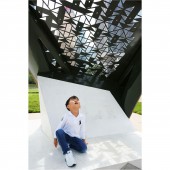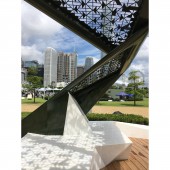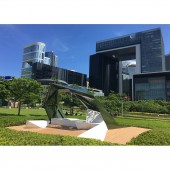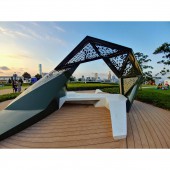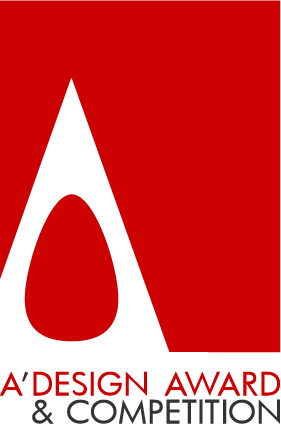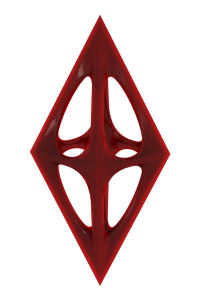
| THE AWARD |
| CATEGORIES |
| REGISTRATION |
| SUBMIT YOUR WORK |
| ENTRY INSTRUCTIONS |
| TERMS & CONDITIONS |
| PUBLICATIONS |
| DATES & FEES |
| METHODOLOGY |
| CONTACT |
| WINNERS |
| PRESS ROOM |
| GET INVOLVED |
| DESIGN PRIZE |
| DESIGN STORE |
| THE AWARD | JURY | CATEGORIES | REGISTRATION | PRESS | WINNERS | PUBLICATIONS | ENTRY INSTRUCTIONS |
Happiness Here Urban Park Seating by Hikoko Ito |
Home > Winners > Design #78807 >Interview |
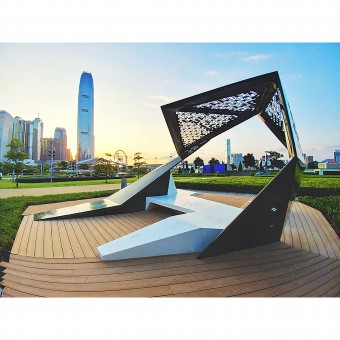 |
|
FS: What is the main principle, idea and inspiration behind your design?
HI: Inspired by the two art forms that reflect our aspirations to happiness, the urban park fixture gained its shape from the paper-folding concept. It presents a continuity that enhances people’s experiences in the transitions of planes. Whereas the canopy’s paper-cutting-like “happiness” art motifs, by Chinese character artist Sun Chan, constitute ornamentation that captures the changing effects of sunlight. The symbolic interplay of light and shade highlights the duality (brightness/darkness, yin/yang) in life at the same time brings an ever-changing appearance and a poetic dimension to the piece.
FS: What has been your main focus in designing this work? Especially what did you want to achieve?
HI: The public seating is meant to be a statement, as well as a design solution. It conveys a much-needed message of happiness to encourage positivity in a city that repeatedly fell short on the global ranking of happiness level. It is to inspire Hongkongers to rediscover pleasures in daily life, while subtly reminding policymakers of their vital role in fostering conditions for a harmonious, happier society.
FS: What are your future plans for this award winning design?
HI: While the seating is enjoyed by the public on a daily basis, special events from mini-concerts to family friendly games activities are also organized regularly on site to promote the seating/place.
FS: How long did it take you to design this particular concept?
HI: It took me about a month to arrive at this design concept.
FS: Why did you design this particular concept? Was this design commissioned or did you decide to pursuit an inspiration?
HI: I was commissioned by The Government of Hong Kong Special Administrative Region to design a public art seating in front of its iconic headquarters building in celebration of the 20th anniversary of the establishment of the Hong Kong Special Administrative Region. It is set out to be iconic, celebratory, and possesses an optimistic character that leads the city to look towards the future.
FS: Is your design being produced or used by another company, or do you plan to sell or lease the production rights or do you intent to produce your work yourself?
HI: This outdoor furniture was produced in parts in mainland China, then transported to Hong Kong and assembled on site. Located in a park right in front of the Hong Kong Special Administrative Region government headquarters was created as a landmark to celebrate the HKSAR’s 20th anniversary.
FS: What made you design this particular type of work?
HI: While I have created other pieces for exhibitions in museum settings, I have even greater satisfactions in creating designs for public places that can engage and interact with more people. As an architect, I also feel privileged to have the opportunity to design quality public spaces, which enhance Hong Kong's image and charm as a world-class city. The underlying theme of the design also projects a positive image of the Hong Kong government that it increasingly cares about its citizens' happiness and well being. Passionately nicknamed by locals as the “happy boat”, it offers an iconic place to rest and gather and is now a popular venue for picnics and mini-concerts alike.
FS: Where there any other designs and/or designers that helped the influence the design of your work?
HI: I have always been amazed and inspired by the novel Chinese-character-motifs created by my late father Sun Chan. With focus on intersections between form, space and the Chinese script, I hope to take his legacy to another level by producing 3D creations infused with his Chinese character motifs which not only adorned the designs with meanings/connotations but also to perpetuate the affectionate tie between my late father and me.
FS: Who is the target customer for his design?
HI: General public
FS: What sets this design apart from other similar or resembling concepts?
HI: When designing for the Hong Kong government a representative seating to celebrate the city’s joyous event, I took a bold move to use my design to address a social issue and promote public as well as the government's awareness of the importance of happiness in a results-driven city that used to focus merely on economic development.
FS: How did you come up with the name for this design? What does it mean?
HI: The urban park furniture poses as a visual adventure, in which various elements intertwined engaging users on multiple levels, to inspire Hongkongers to savor pleasant moments in day-to-day lives. Upon initial encounter, it strikes people as mysteriously as an abstract painting, and only through a journey of exploration that they get to experience and appreciate it layer by layer. Through its origami form, its paper-cutting-like “happiness” art motifs, and its light-hearted “happy icons”, the urban park seating lifts spirits and evokes cheerful emotions.
FS: Which design tools did you use when you were working on this project?
HI: Computer programme such as SketchUp and AutoCAD
FS: What is the most unique aspect of your design?
HI: This anchor piece to the symbolic site is infused with cultural references (namely origami & paper-cutting) drawn from my mixed (Japanese-Chinese) heritage. Usage of the Chinese character art motifs is also a tribute to my late beloved father, Sun Chan, who passed away the same year I was commissioned this project.
FS: Who did you collaborate with for this design? Did you work with people with technical / specialized skills?
HI: The theme of the design is "Happiness", and when it comes to happiness, small children are often our best teachers. Through workshops held in Jan-Mar 2017, local primary schools kids created fifty “happy icons” from the things that make them happy. These graphic emblems are then engraved onto the white marble seating. Shadows cast by my late father's “happiness” art motifs upon the kids’ “happy icons” forge a silent dialogue between authors of the two generations. It yields a calming, contemplative atmosphere that touches users on deeper spiritual levels.
FS: What is the role of technology in this particular design?
HI: The steel framework was pre-fabricated in parts to enable better control of the overall finishing. Marble slabs were pre-cut with more acute-angled pieces glued together at the factory to minimize the risk of breaking. Overall, the project is completed with good workmanship and to the client’s satisfaction. The canopy’s double layers of Galvanized Mild Steel (GMS) with coated car paint prove to be robust & durable, while white polished marble enriches the seating with luminosity, purity, and a feel of minimalist elegance. Its cooling effect also makes it a great material for outdoor seating in Hong Kong’s hot weather. The wood-plastic composite boards used for the floor decking are made from recycled plastics and waste wood. They have a long life span and require no environmentally unfriendly maintenance like staining or sealing.
FS: Is your design influenced by data or analytical research in any way? What kind of research did you conduct for making this design?
HI: Before the design process commenced, on-site surveys of over two hundred park users revealed that most people prefer shading in the open site; while some opt to sit in the sun. Thus the design adopts a canopy with patterned openings to provide choices of shaded, partially-shaded and exposed seating. In the end, it results in a form that echoes with the “open-door-frame” government headquarters in its background.
FS: What are some of the challenges you faced during the design/realization of your concept?
HI: As there are many city mains right beneath the site, the footing of the structure has to be reduced in thickness, but extended in area coverage to make up for the loading tolerance. Also, since the site is right in front of the headquarters of the HKSAR government and the army forces, there are many restrictions imposed on the on-site construction (from duration to the height of temporary structure). Thus the designer had to work promptly with the contractor to resolve various problems in-situ.
FS: How did you decide to submit your design to an international design competition?
HI: I was encouraged by the client to submit the design for the A' Design Award competition.
FS: Any other things you would like to cover that have not been covered in these questions?
HI: Its design, materials used and construction methods all complied with standards and regulatory requirements of Hong Kong with its structural integrity verified by a registered structural engineer. All edges and angles are rounded for safety reason. Perforations on the canopy are made larger than 25mm to prevent finger entrapment, and their inside rims polished to avoid sharp edges.
FS: Thank you for providing us with this opportunity to interview you.
A' Design Award and Competitions grants rights to press members and bloggers to use parts of this interview. This interview is provided as it is; DesignPRWire and A' Design Award and Competitions cannot be held responsible for the answers given by participating designers.
| SOCIAL |
| + Add to Likes / Favorites | Send to My Email | Comment | View Press-Release |

